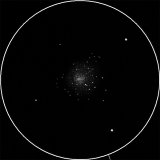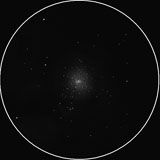
| MESSIER 15 |
|---|
RA: |
21h 30m 00s |
|
DEC: |
+12° 10' 00'' |
|
Type: |
Globular Cluster |
|
NGC: |
7078 |
|
Magnitude: |
6.20 |
|
Surface brightness : |
11.3 |
|
Apparent dimensions : |
12'x12' |
|
Distance: |
34,000 ly |
|
Globular Cluster M15 (also known as Messier Object 15 or NGC 7078) is a globular cluster in the constellation Pegasus. It was discovered by Jean-Dominique Maraldi in 1746 and included in Charles Messier's catalog of comet-like objects in 1764. It is estimated to be 13.2 billion years old, one of the oldest globular clusters. M15 is at a distance of about 33,600 light-years from Earth. It has an absolute magnitude of -9.2 which translates to a total luminosity of 360,000 times that of the Sun. Messier 15 is one of the most densely packed globulars known in the Milky Way galaxy. The core of this cluster has undergone a contraction known as core collapse and it has a central density cusp, with an enormous number of stars surrounding what may be a central black hole. Messier 15 contains a rather high number of variable stars; 112 of these are known to reside within its mass of stars. There have also been found to be at least 8 pulsars in M15 including one double neutron star system, M15 C. Moreover, M15 houses one of only four planetary nebulae known in a globular cluster, Pease 1, discovered in 1928. To the amateur astronomer Messier 15 appears as a fuzzy star in the smallest of telescopes. Mid to large size telescopes (at least 6 in./150 mm diameter) will start to reveal individual stars, the brightest of which are of magnitude +12.6. |
||
Other sketches |
|||||
 |
|||||
Messier 15 (August 2006.) |
|||||
VEDRAN VRHOVAC© 2006.-2007. |
